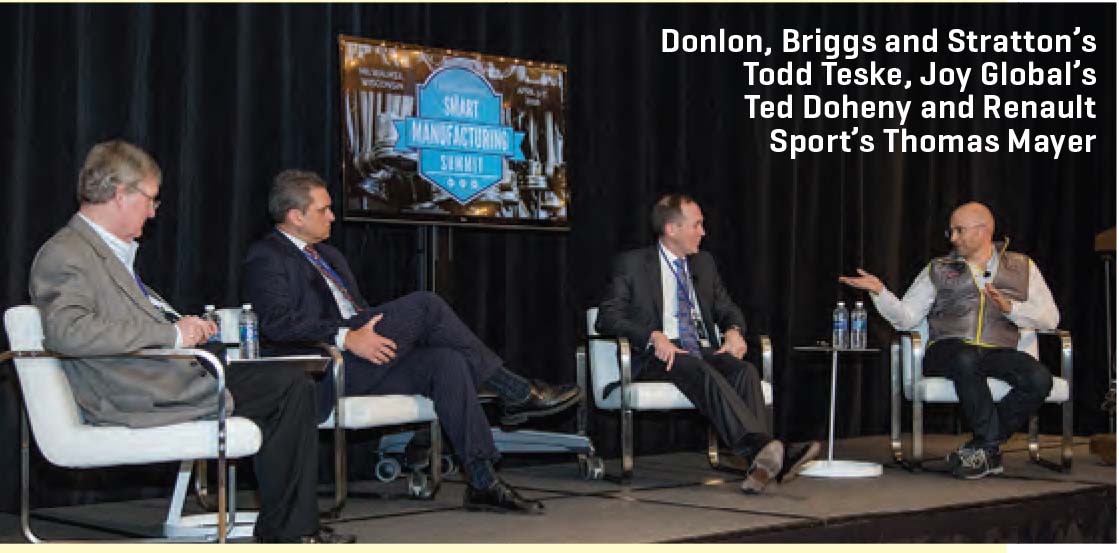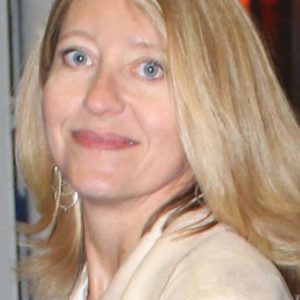ON HARNESSING THE POTENTIAL OF MACHINE LEARNING…
 Thomas Mayer, COO of Renault Sport Formula One Team: “We created a digital twin of the real Formula One car. It’s a virtual model, a mathematical model down to the screw, that allows us to have a reverse design and manufacturing approach that we didn’t have before.
Thomas Mayer, COO of Renault Sport Formula One Team: “We created a digital twin of the real Formula One car. It’s a virtual model, a mathematical model down to the screw, that allows us to have a reverse design and manufacturing approach that we didn’t have before.
Instead of producing a part and then fine-tuning it through trial and error testing—wind tunnel, track testing—we can use virtual data, put the drivers into the simulator and let them run. Then, if we are able to extract performance, meaning get the car to go faster, we go back and starting producing. We tell the engineers, “Look, that’s the physical property of the part you need to design.” That way, we are just physically producing one part, the part we are actually putting [into] the car. We save time, we save money, we iterate faster—and all of that brings performance.”
Ted Doheny, CEO of mining equipment company Joy Global: “In mining, the challenges today are immense. In the last four years, the prices of commodities across the board have been cut in half, so our customers are under a lot of pressure. We use sensors and the IoT to solve mining challenges.
Our longwall shearing system, one of the most automated pieces of mining equipment, is a good example. Where a mine once had more than 35 people underground, we now have 7,000 sensors and 140 cameras that constantly monitor and control processes, transmitting data between machines and up to the surface. If that longwall system goes down, it’s $1,500 a minute. So we help our customers use this data to predict a problem and get the inventory in place to make a repair before it goes down. As we drive automation, we look to simplify the process, eliminate waste and remove people from harm’s way. For one of our customers, automation was able to eliminate $100 million of waste and reduce 35 people working underground down to less than five.”
 Todd Teske, CEO of engine manufacturer Briggs and Stratton: “One of the ways we’ve dipped our toe in the water with IoT is on our standby generators, which go on automatically and power your house during an outage. What we’re really selling is peace of mind; but with a mechanical piece of equipment, things can go wrong. As a homeowner, you want to know when your unit stops cycling regularly so that you can get the unit fixed before you actually need it.
Todd Teske, CEO of engine manufacturer Briggs and Stratton: “One of the ways we’ve dipped our toe in the water with IoT is on our standby generators, which go on automatically and power your house during an outage. What we’re really selling is peace of mind; but with a mechanical piece of equipment, things can go wrong. As a homeowner, you want to know when your unit stops cycling regularly so that you can get the unit fixed before you actually need it.
 “We developed an app that you can pull up on your phone to check to see that your generator cycled successfully. If there’s a fault, it will notify you and tell you the dealer to call near your house who can get it fixed. We think the commercial applications will be quite interesting. We think we can drive better productivity, which means uptime, which means better billing cycles, for our customer base.”
“We developed an app that you can pull up on your phone to check to see that your generator cycled successfully. If there’s a fault, it will notify you and tell you the dealer to call near your house who can get it fixed. We think the commercial applications will be quite interesting. We think we can drive better productivity, which means uptime, which means better billing cycles, for our customer base.”
ON WHAT THEY LEARNED ALONG THE WAY…
Meyer: “At the end of the day, it’s about making the right decisions—in our case, do we pit the car or not? But sensors can have the wrong readings. Whenever we have an alert, we crosscheck it with two or three other sensors and put the physics behind it to see if what the sensor is telling us is even possible. Otherwise, we could retire a car just because we have wrong information coming from the sensor.”
 Doheny: “Once you’re embedded into your customer’s system, you need to be able to handle the truth both ways. Ever since we did our first smart-services center, we’ve been able to tell which operating crews in the mine were the best. We can tell when people are not working as they should. Vice versa, our customer could tell when we had an equipment problem. It’s a different relationship when you have that much data. The question becomes, what will you do with it? We focus on three things obsessively: safety, production and cost. If it moves the needle on those elements, that’s where we should focus.”
Doheny: “Once you’re embedded into your customer’s system, you need to be able to handle the truth both ways. Ever since we did our first smart-services center, we’ve been able to tell which operating crews in the mine were the best. We can tell when people are not working as they should. Vice versa, our customer could tell when we had an equipment problem. It’s a different relationship when you have that much data. The question becomes, what will you do with it? We focus on three things obsessively: safety, production and cost. If it moves the needle on those elements, that’s where we should focus.”
Teske: “You do need to decide what to do with all this data. We went back to our framework and how we talk about innovation, because innovation is an overused word that means something different to everybody. We defined it as user-driven problem-solving and that’s where we started. We looked at how we accumulate data and communicate it so that it becomes information that ultimately solves a problem, whatever that problem is, for the user.”

Chief Executive Group exists to improve the performance of U.S. CEOs, senior executives and public-company directors, helping you grow your companies, build your communities and strengthen society. Learn more at chiefexecutivegroup.com.
0

1:00 - 5:00 pm
Over 70% of Executives Surveyed Agree: Many Strategic Planning Efforts Lack Systematic Approach Tips for Enhancing Your Strategic Planning Process
Executives expressed frustration with their current strategic planning process. Issues include:
Steve Rutan and Denise Harrison have put together an afternoon workshop that will provide the tools you need to address these concerns. They have worked with hundreds of executives to develop a systematic approach that will enable your team to make better decisions during strategic planning. Steve and Denise will walk you through exercises for prioritizing your lists and steps that will reset and reinvigorate your process. This will be a hands-on workshop that will enable you to think about your business as you use the tools that are being presented. If you are ready for a Strategic Planning tune-up, select this workshop in your registration form. The additional fee of $695 will be added to your total.

2:00 - 5:00 pm
Female leaders face the same issues all leaders do, but they often face additional challenges too. In this peer session, we will facilitate a discussion of best practices and how to overcome common barriers to help women leaders be more effective within and outside their organizations.
Limited space available.

10:30 - 5:00 pm
General’s Retreat at Hermitage Golf Course
Sponsored by UBS
General’s Retreat, built in 1986 with architect Gary Roger Baird, has been voted the “Best Golf Course in Nashville” and is a “must play” when visiting the Nashville, Tennessee area. With the beautiful setting along the Cumberland River, golfers of all capabilities will thoroughly enjoy the golf, scenery and hospitality.
The golf outing fee includes transportation to and from the hotel, greens/cart fees, use of practice facilities, and boxed lunch. The bus will leave the hotel at 10:30 am for a noon shotgun start and return to the hotel after the cocktail reception following the completion of the round.